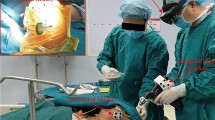Abstract
Ultrasound (US) is a popular medical imaging technique in the clinic due to its low cost, high portability, and real-time diagnostic value. A special type of ultrasound technique, transcranial Doppler (TCD) ultrasound can be used to measure blood flows in cerebral blood vessels through acoustic bone windows of the intact human skull. Although TCD ultrasound is commonly used to diagnose and monitor a range of neurovascular conditions, such as stroke, interpretation of the image content in the TCD scans and quick localization of the targeted blood vessels with it can be difficult due to inherent challenges of its unique image contrasts, relatively low image quality, and 2D nature of the technique in relation to the 3D brain anatomy that is invisible to the clinician. These drawbacks may hinder the efficiency and even accuracy of the TCS examinations, especially for novel users. To render the procedure more efficient and intuitive, we developed a prototype of augmented-reality system to guide the procedure by fusing a population-averaged probabilistic blood vessel atlas with camera footages of the patient. The system prototype was demonstrated with healthy subjects, and is expected to facility the clinical TCD examination, as well as to help in the educational context for new clinicians and clinical technicians.







Similar content being viewed by others
References
Aubert-Broche B, Griffin M, Pike GB, Evans AC, Collins DL (2006) Twenty new digital brain phantoms for creation of validation image data bases. IEEE Trans Med Imaging 25(11):1410–1416
Chang WM, Amesur NB, Horowitz MB, Stetten GD (2004) Refining the sonic flashlight for interventional procedures. 2004 2nd IEEE Int Sym Biomed Imaging: Macro Nano 1 and 2:1545–1548
De Nigris D, Collins DL, Arbel T (2013) Fast rigid registration of pre-operative magnetic resonance images to intra-operative ultrasound for neurosurgery based on high confidence gradient orientations. Int J Comput Ass Rad 8(4):649–661
Drouin S, Kersten-Oertel M (2015) Collins DL (2015) interaction-based registration correction for improved augmented reality overlay in neurosurgery. Augmented Environ Comput-Assisted Interven, Ae-Cai 9365:21–29
Drouin S, Kochanowska A, Kersten-Oertel M, Gerard IJ, Zelmann R, De Nigris D, Beriault S, Arbel T, Sirhan D, Sadikot AF, Hall JA, Sinclair DS, Petrecca K, DelMaestro RF, Collins DL (2017) IBIS: an OR ready open-source platform for image-guided neurosurgery. Int J Comput Assist Radiol Surg 12(3):363–378
Evans AC, Collins DL, Mills SR, Brown ED, Kelly RL, Peters TM (1993) 3d Statistical Neuroanatomical Models from 305 Mri Volumes. Nucl Sci Sym Med Imaging Conf 1-3:1813–1817
Fonov V, Evans AC, Botteron K, Almli CR, McKinstry RC, Collins DL, Grp BDC (2011) Unbiased average age-appropriate atlases for pediatric studies. NeuroImage 54(1):313–327
Francesconi M, Freschi C, Sinceri S, Carbone M, Cappelli C, Morelli L, Ferrari V, Ferrari M (2015) New training methods based on mixed reality for interventional ultrasound: design and validation. IEEE Eng Med Bio:5098–5101
Frangi AF, Niessen WJ, Vincken KL, Viergever MA (1998) Multiscale vessel enhancement filtering. Lect Notes Comput Sc 1496:130–137
Gerard IJ, Kersten-Oertel M, Drouin S, Hall JA, Petrecca K, De Nigris D, Arbel T, Louis Collins D (2016) Improving patient specific neurosurgical models with intraoperative ultrasound and augmented reality visualizations in a Neuronavigation environment. In: Oyarzun Laura C, Shekhar R, Wesarg S et al (eds) Clinical image-based procedures. Translational research in medical imaging: 4th International workshop, CLIP 2015, held in conjunction with MICCAI 2015, Munich, Germany, October 5, 2015. Revised selected papers. Springer International publishing, Cham, pp 28–35
Kersten-Oertel M, Chen SS, Drouin S, Sinclair DS, Collins DL (2012) Augmented reality visualization for guidance in neurovascular surgery. Stud Health Technol Inform 173:225–229
Kersten-Oertel M, Gerard I, Drouin S, Mok K, Sirhan D, Sinclair DS, Collins DL (2015) Augmented reality in neurovascular surgery: feasibility and first uses in the operating room. Int J Comput Assist Radiol Surg 10(11):1823–1836
Lagana MM, Preti MG, Forzoni L, D'Onofrio S, De Beni S, Barberio A, Cecconi P, Baselli G (2013) Transcranial ultrasound and magnetic resonance image fusion with virtual navigator. IEEE T Multimed 15(5):1039–1048
Lerotic M, Chung AJ, Mylonas G, Yang GZ (2007) Pq-space based non-photorealistic rendering for augmented reality. Med Image Comput Comput Assist Interv 10(Pt 2):102–109
Liu Y, Nie LQ, Liu L, Rosenblum DS (2016) From action to activity: sensor-based activity recognition. Neurocomputing 181:108–115
Liu Y, Zhang L, Nie L, Yan Y, Rosenblum DS (2016) Fortune teller: predicting your career path. Paper presented at the proceedings of the thirtieth AAAI conference on artificial intelligence, Phoenix, Arizona
Palmer CL, Haugen BO, Tegnander E, Eik-Nes SH, Torp H, Kiss G (2015) Mobile 3D augmented-reality system for ultrasound applications. IEEE Int Ultra Sym
Schreiber SJ, Sakas G, Kolev V, Beni SD (2014) Fusion imaging in neurosonology: Clinician’s questions, technical potentials and applicability. Biomed Eng Lett 4(4):347–354
State A, Livingston MA, Garrett WF, Hirota G, Whitton MC, Pisano ED, Fuchs H (1996) Technologies for augmented reality systems: realizing ultrasound-guided needle biopsies. Paper presented at the proceedings of the 23rd annual conference on computer graphics and interactive techniques
Wolfsberger S, Rossler K, Regatschnig R, Ungersbock K (2002) Anatomical landmarks for image registration in frameless stereotactic neuronavigation. Neurosurg Rev 25(1–2):68–72
Author information
Authors and Affiliations
Corresponding author
Ethics declarations
Conflicts of interest
The authors declare that they have no conflict of interest.
Ethical approval
All procedures performed in studies involving human participants were in accordance with the ethical standards of the institutional and/or national research committee and with the 1964 Helsinki declaration and its later amendments or comparable ethical standards.
Informed consent
Informed consent was obtained from all participants included in the study.
Rights and permissions
About this article
Cite this article
Xiao, Y., Drouin, S., Gerard, I.J. et al. An augmented-reality system prototype for guiding transcranial Doppler ultrasound examination. Multimed Tools Appl 77, 27789–27805 (2018). https://doi.org/10.1007/s11042-018-5990-9
Received:
Revised:
Accepted:
Published:
Issue Date:
DOI: https://doi.org/10.1007/s11042-018-5990-9




